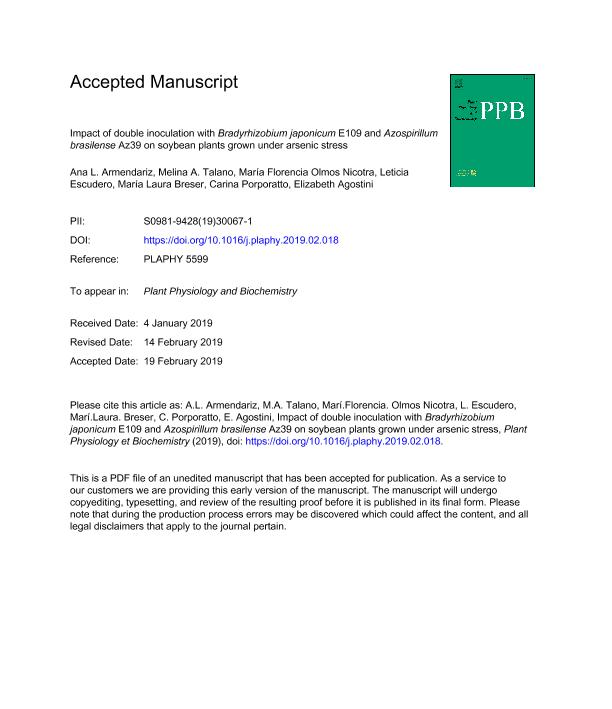Artículo
Impact of double inoculation with Bradyrhizobium japonicum E109 and Azospirillum brasilense Az39 on soybean plants grown under arsenic stress
Armendariz, Ana Laura ; Talano, Melina Andrea
; Talano, Melina Andrea ; Olmos Nicotra, Maria Florencia
; Olmos Nicotra, Maria Florencia ; Escudero, Leticia Belén
; Escudero, Leticia Belén ; Breser, Maria Laura
; Breser, Maria Laura ; Porporatto, Carina
; Porporatto, Carina ; Agostini, Elizabeth
; Agostini, Elizabeth
 ; Talano, Melina Andrea
; Talano, Melina Andrea ; Olmos Nicotra, Maria Florencia
; Olmos Nicotra, Maria Florencia ; Escudero, Leticia Belén
; Escudero, Leticia Belén ; Breser, Maria Laura
; Breser, Maria Laura ; Porporatto, Carina
; Porporatto, Carina ; Agostini, Elizabeth
; Agostini, Elizabeth
Fecha de publicación:
05/2019
Editorial:
Elsevier France-editions Scientifiques Medicales Elsevier
Revista:
Plant Physiology and Biochemistry
ISSN:
0981-9428
Idioma:
Inglés
Tipo de recurso:
Artículo publicado
Clasificación temática:
Resumen
Inoculation practice with plant growth-promoting bacteria (PGPB) has been proposed as a good biotechnological tool to enhance plant performance and alleviate heavy metal/metalloid stress. Soybean is often cultivated in soil with high arsenic (As) content or irrigated with As-contaminated groundwater, which causes deleterious effects on its growth and yield, even when it was inoculated with rhizobium. Thus, the effect of double inoculation with known PGPB strains, Bradyrhizobium japonicum E109 and Azospirillum brasilense Az39 was evaluated in plants grown in pots under controlled conditions and treated with As. First, the viability of these co-cultivated bacteria was assayed using a flow cytometry analysis using SYTO9 and propidium iodide (PI) dyes. This was performed in vitro to evaluate the bacterial population dynamic under 25 μM AsV and AsIII treatment. A synergistic effect was observed when bacteria were co-cultured, since mortality diminished, compared to each growing alone. Indole acetic acid (IAA) produced by A. brasilense Az39 would be one of the main components involved in B. japonicum E109 mortality reduction, mainly under AsIII treatment. Regarding in vivo assays, under As stress, plant growth improvement, nodule number and N content increase were observed in double inoculated plants. Furthermore, double inoculation strategy reduced As translocation to aerial parts thus improving As phytostabilization potential of soybean plants. These results suggest that double inoculation with B. japonicum E109 and A. brasilense Az39 could be a safe and advantageous practice to improve growth and yield of soybean exposed to As, accompanied by an important metalloid phytostabilization.
Palabras clave:
ARSENIC
,
GLYCINE MAX
,
INOCULATION
,
PGPB
,
PHYTOSTABILIZATION
Archivos asociados
Licencia
Identificadores
Colecciones
Articulos(CCT - CORDOBA)
Articulos de CTRO.CIENTIFICO TECNOL.CONICET - CORDOBA
Articulos de CTRO.CIENTIFICO TECNOL.CONICET - CORDOBA
Articulos(CCT - MENDOZA)
Articulos de CTRO.CIENTIFICO TECNOL.CONICET - MENDOZA
Articulos de CTRO.CIENTIFICO TECNOL.CONICET - MENDOZA
Articulos(ICIVET-LITORAL)
Articulos de INST. DE CIENCIAS VETERINARIAS DEL LITORAL
Articulos de INST. DE CIENCIAS VETERINARIAS DEL LITORAL
Citación
Armendariz, Ana Laura; Talano, Melina Andrea; Olmos Nicotra, Maria Florencia; Escudero, Leticia Belén; Breser, Maria Laura; et al.; Impact of double inoculation with Bradyrhizobium japonicum E109 and Azospirillum brasilense Az39 on soybean plants grown under arsenic stress; Elsevier France-editions Scientifiques Medicales Elsevier; Plant Physiology and Biochemistry; 138; 5-2019; 26-35
Compartir
Altmétricas



